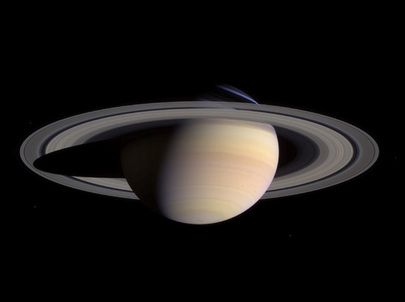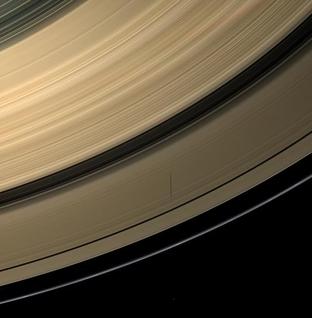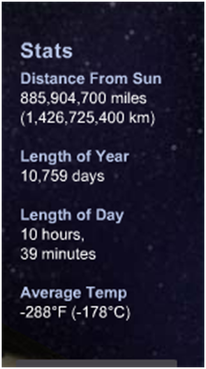Our Solar System
Planet Saturn

Saturn is a gas giant made up mostly of hydrogen and helium. Saturn is the second largest planet, big enough to hold more than 760 Earths, and is more massive than any other planet except Jupiter, roughly 95 times Earth's mass. However, Saturn has the lowest density of all the planets, and is the only one less dense than water — if there were a bathtub big enough to hold it, Saturn would float on top.
Although the other gas giants in the solar system — Jupiter, Uranus and Neptune — also have rings, those of Saturn are without a doubt the most extraordinary. The largest one to date spans up to 200 times the diameter of the planet.
Saturn is the farthest planet from Earth visible to the naked human eye. The yellow and gold bands seen in the planet's atmosphere are the result of super-fast winds in the upper atmosphere, which can reach up to 1,100 miles per hour (1,800 kilometers per hour) around its equator, combined with heat rising from the planet's interior.
Saturn spins faster than any other planet except Jupiter, completing a rotation roughly every 10-and-a-half hours. This rapid spinning causes Saturn to bulge at its equator and flatten at its poles — the planet is 8,000 miles (13,000 kilometers) wider at its equator than between the poles.
Saturn's most recent curiosity may be the giant hexagon circling its north pole, with each of its sides nearly 7,500 miles (12,500 kilometers) across — big enough to fit nearly four Earths inside. Thermal images show it reaches some 60 miles (100 kilometers) down into the planet's atmosphere. It remains uncertain what causes it.
Although the other gas giants in the solar system — Jupiter, Uranus and Neptune — also have rings, those of Saturn are without a doubt the most extraordinary. The largest one to date spans up to 200 times the diameter of the planet.
Saturn is the farthest planet from Earth visible to the naked human eye. The yellow and gold bands seen in the planet's atmosphere are the result of super-fast winds in the upper atmosphere, which can reach up to 1,100 miles per hour (1,800 kilometers per hour) around its equator, combined with heat rising from the planet's interior.
Saturn spins faster than any other planet except Jupiter, completing a rotation roughly every 10-and-a-half hours. This rapid spinning causes Saturn to bulge at its equator and flatten at its poles — the planet is 8,000 miles (13,000 kilometers) wider at its equator than between the poles.
Saturn's most recent curiosity may be the giant hexagon circling its north pole, with each of its sides nearly 7,500 miles (12,500 kilometers) across — big enough to fit nearly four Earths inside. Thermal images show it reaches some 60 miles (100 kilometers) down into the planet's atmosphere. It remains uncertain what causes it.
Saturn Rings

The most striking feature of Saturn is to most people the series of rings which encircle it. They were first spotted in 1610 by the great Italian astronomer Galileo Galilei, who was mystified as to why Saturn appeared to have two circles, or 'cup holders' on either side of it. It wasn't until a few decades later, in 1659, that the Dutch astronomer Christiaan Huygens discovered that they were actually separate from the planet, and must therefore be encircling it. Just 16 years later, Cassini discovered the 'Cassini division' - a small gap in the middle of the ring system between what are now termed the A and B rings, the A ring being the innermost one and the B ring being further out. The reason for this 4,800km-wide gap in the rings is that Saturn's moon Mimas orbits at this distance from the planet, and has 'swept up' the rocks which form the ring system which surrounding it. The Cassini division is clearly visible on any detailed picture of Saturn and its rings, such as the one at the top of this page. Subsequent observations have also found several more separate rings around Saturn, with the outermost being termed the F ring..
Though they look solid from a distance, the rings are actually quite insubstantial and are made up of rocks and blocks of water ice varying in size from a few tens of meters to a few micrometers (0.000001 meter) in diameter. The overall effect made by all of these small rocks around Saturn is quite remarkable, especially given the typical thickness of the main rings is only about 10 meters, and the ring system unique on this scale in our Solar System. The thinness of the rings is all the more remarkable given they extend outwards to hundreds of thousands of kilometers, roughly to the same distance from Saturn's surface as the Moon is to the Earth's.
Though they look solid from a distance, the rings are actually quite insubstantial and are made up of rocks and blocks of water ice varying in size from a few tens of meters to a few micrometers (0.000001 meter) in diameter. The overall effect made by all of these small rocks around Saturn is quite remarkable, especially given the typical thickness of the main rings is only about 10 meters, and the ring system unique on this scale in our Solar System. The thinness of the rings is all the more remarkable given they extend outwards to hundreds of thousands of kilometers, roughly to the same distance from Saturn's surface as the Moon is to the Earth's.

